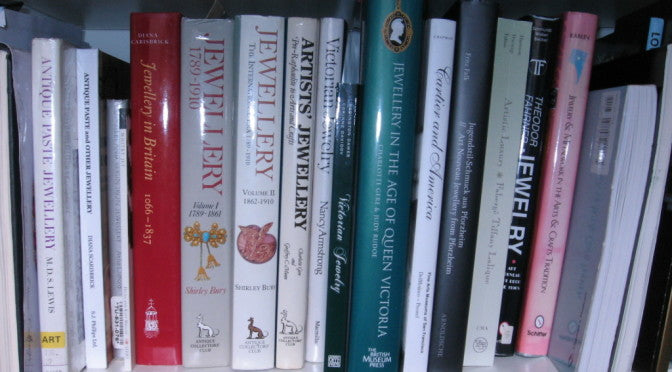While these books contain information about prices, I don’t recommend using them as price guides because most were written several years ago. In fact, I don’t think books are a particularly good source of pricing these days; much better information can be found by doing research on the internet. The best way to research prices is by using these books to help you figure out what you have acquired. Then you can search for pricing of comparable items on sites like Ruby Lane, Etsy, and 1st Dibs; through a general Google search; and from auction sales results.

If I were to have to choose one “desert island” jewelry book it would be Warman’s Jewelry, by Christie Romero. Though out of print, my favorite is the 3rd edition as it has sections about studio jewelry, Scandinavian jewelry, native American jewelry, and Mexican jewelry that are lacking in the current 5th edition. Well-written, informative, and covering both fine and costume jewelry from the late 18th century through the 1970’s, this is the best all-around book on the market. There is an excellent timeline with milestone events and inventions in the jewelry world alongside important events in world history. There are also appendices with information about hallmarks and maker’s marks, and a glossary of jewelry terminology. As of September 2014, as I write this post, Warman’s Jewelry, 3rd edition is readily available on the secondary marketplace through Amazon and other online retailers.
Romero’s book does a good job of covering American costume jewelry but its coverage of European costume jewelry is limited. European Designer Jewelry by Ginger Moro fills that gap. With sumptuous photographs, it will help you identify pieces that are less commonly found in the United States. There is really no other book on the market that covers this information in a comprehensive way.
Collectible Silver Jewelry by Fred Rezazadeh focuses on silver jewelry throughout the world. Each chapter covers a specific country and opens with information about important manufacturers and includes photos or drawings of their maker’s marks. Each chapter then proceeds with photos of silver jewelry from that country and price ranges for it. This isn’t a book to buy for gorgeous photos or for photos of exceptional jewelry. However, this is one of its strong points: it includes photos of relatively ordinary silver jewelry, the kind you are most likely to encounter at garage sales and flea markets, rather than the great pieces that many jewelry books exclusively focus on.
Understanding Jewelry by David Bennett and Daniela Mascetti focuses primarily on great jewelry but also includes some examples of lesser fine jewelry. It is considered a modern classic in the field of jewelry history. With its beautiful photos and highly informative text, it will help you train your eye to recognize the design characteristics of each period of antique and vintage jewelry.
With these books as references you will be in a good position to identify a great deal of the jewelry that you encounter. As you continue to collect, you can add specialty jewelry books to your library that cover specific periods, materials, and designers that interest you.
Most books I mentioned above are available via the Amazon links below or through J.M. Cohen Rare Books, a dealer who specializes in jewelry books.


